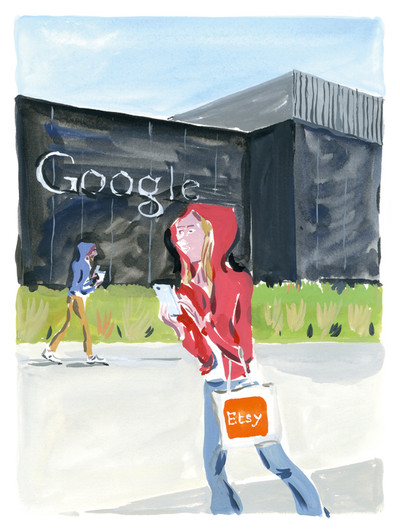Is the reality of tech killing the fantasy of fashion?
By Nina Khosla
Illustration by Jean-Philippe Delhomme
Is the reality of tech killing the fantasy of fashion?

My love for the Internet has been a big part of my life. I grew up in Silicon Valley, watching my dad invest in start-ups. I also grew up on the Internet. I bought my first domain name in 2000, where I hosted both my blog and various Photoshop experiments, and after attending Stanford University, where I studied product design, I founded a start-up that focused on online communities. I’ve spent the last few years immersing myself in bag design, getting ready to launch my own label.
Ten years ago, the question around Silicon Valley was how to create a more open world. There was a lot of talk about creating platforms that would let people speak their minds, changing the way we communicate. We did that with the inception of social media: Facebook, Instagram, and Twitter. Just last week, I was sitting at my computer, watching a YouTube vlogger recommend lipstick, saying the best one was actually available on Etsy – an online marketplace built on its sense of community. I Googled the Etsy store, finding that the only product reviews were on Internet forum Reddit. None of these platforms are vetted by PRs or business execs, and no one there needs to ask permission to share their views or sell products. There are no gatekeepers.
No one saw how these platforms would affect culture, however. Today, we see these sites and apps filled with ‘influencers’ and ‘trolls’, with the ‘memeification’ of cultural concepts, and the spread of fake news. It reminds me of a very basic fact: technology and culture are two sides of the same coin. Progress in one area deeply affects the other; they’re two forces constantly engaging with each other, one able to pull the other off course. Tied to this interaction is fashion. Because like tech, it’s an industry concerned with change. In tech, we’re fascinated with innovation – what technological change is coming next? Fashion is not dissimilar in how it responds to cultural shifts.
Yet it increasingly seems that rather than leading culture, the fashion industry is simply responding to a changing landscape and developing in line with technology. “Normcore” was a trend called out and named by an online collective. Techy fabrics and “athleisure” didn’t start in an atelier. If fashion wants to be seen as promulgating change, it needs to better understand and react to how people live now.
Looking at the fashion industry, it seems that the companies that understand this best are the ones thriving. Fast fashion, for example, seems built to succeed in a new cultural and technological landscape, reflecting a new reality in which consumers only want to wear something once, have a photo captured for Facebook, then move onto the next thing. Brands like Zara and H&M have transformed their manufacturing and supply chains in order to allow them to react swiftly to this behavioural shift.
It’s not just your local Zara quickly adjusting. A new range of e-commerce companies like Everlane, Warby Parker, Cuyana and Outdoor Voices are catching up, and represent a new business model. If fast fashion is a reflection of the rise of the personal-style-blogging ‘influencer’, these companies reflect a back-to-basics trend that almost dares you to notice you’ve worn the same thing twice.
Hundreds of these small, niche brands have emerged in the last 5-10 years, serving passionate communities that believe in the message and values these brands present. These companies don’t look to influencers or celebrities to be the face of their brand because they don’t need them. They know their customers intimately, building online communities in which they really engage, and use knowledge of their customers to craft stories that represent not just a brand, but a cultural ideal. Without this connection to the realities of their customers’ lives, the ideas these brands propose would lack depth. Big-name designers might be blazoning T-shirts with slogans declaring, ‘We are all feminists’, but shop owners on Etsy are creating pins and patches that reflect the attitudes of an authentic community.
Adopting a more holistic view of how people live and how clothes are a part of that is central to selling in the 21st century. Design can’t just be about surface. We need to stop only thinking of models on a catwalk, and instead consider real people in real situations – how clothes are worn, and what their use means to customers. If we don’t, the idea of fashion as an insider industry, relevant only to those inside it, is more and more likely to become a reality. The fashion industry may love fantasy and whimsy, but to begin changing the way people think at a deep, structural level, we have got to work harder to engage with reality, and understand how customers actually think.